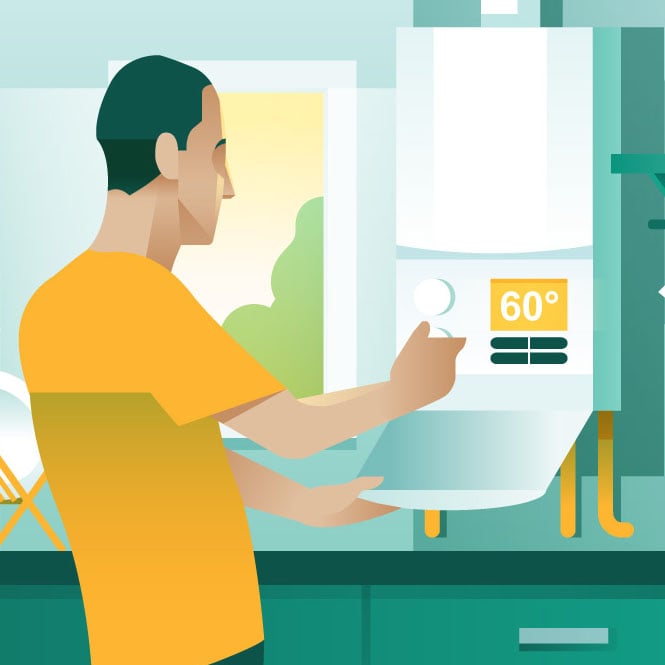Frequently asked questions
-
How does it work?
Combi boilers work best when they heat the water that goes to the radiators at 60°C or below (this is called the ‘flow temperature’).
Most boilers in the UK are set at flow temperatures much higher than 60°C (often 70-80°C)
A flow temperature of 60°C means your combi boiler will be in condensing mode. When your combi boiler is in condensing mode it will recover heat that would otherwise be lost so that it runs more efficiently.
-
What is boiler flow temperature?
The flow temperature is the temperature that a boiler heats water up to before it goes around the radiators in your home.
Changing the flow temperature on a combi boiler will not affect the temperature of the hot water from your taps and showers.
-
Can I do this if I have a hot water tank?
Unfortunately we’re unable to suggest that you reduce your boiler flow temperature if you have a water tank.
Our guidance doesn’t currently cover central heating systems that have a hot water tank. You can read more about this at Which.co.uk
-
How do I change my boiler flow temperature?
Use our simple, step-by-step online tool to lower your boiler flow temperature.
If you are struggling to alter the settings using our tool, freeboilermanuals.com has a catalogue of manuals. You can search by the manufacturer and model of your boiler or your boiler’s GC number. Every boiler has a GC number – it’s usually on the front of the boiler. It starts with GC and is followed by a seven-digit number. Within the manual, there will be guidance on how to alter your flow temperature.
-
Why should I set my flow temperature to 60 degrees?
A flow temperature of 60°C means your combi boiler will be in condensing mode. When your combi boiler is in condensing mode it will recover heat that would otherwise be lost so that it runs more efficiently.
You can try going lower than 60°C. The lower you go, the more you’ll save. Try reducing the temperature further in 5°C increments. You can also lower your flow temperature more in Spring and increase it in the colder months.
-
How much money will I save?
An average household could save up to £65 per year in energy costs by adjusting the boiler flow settings to 60°C or below.
We estimate that a medium-sized household (~11,500 kWh of annual gas consumption) would reduce its annual gas consumption by 8% when lowering flow temps from 75°C to 60°C. This saving equates to 940 kWh of gas, which, at 6.91p per kWh of gas, equates to £65.*
A high-use household uses 17,000 kWh of gas every year. This equates to a £94-a-year saving from lowering flow temperatures from 75°C to 60°C.
*Based on energy prices as at September 2023.
-
Why are my radiators cooler than before?
As the boiler is heating the water in your radiators to around 60°C, they may feel cooler than before the change. This is to be expected – they will still heat your home effectively but rooms may take a little longer to warm up (see below).
-
Why is my home taking longer to warm up?
As your radiators are cooler, your home will take slightly longer to heat up. For many people, this difference isn’t noticeable.
If you find your rooms are taking too long to heat up, you may want to increase the flow temperature by 5°C.
-
Why does my home feel cooler than before I changed the settings?
If your home is particularly draughty or poorly insulated, you may find that lowering your boiler flow temperature leads to cooler rooms.
If you find your rooms are taking too long to heat up, you may want to increase the flow temperature by 5°C. Leave it at this new setting for a few days and see whether your comfort improves. You can keep doing this until you find a temperature that works for you and your home.
-
Should I go lower than 60 degrees?
Many homes can be heated at flow temperatures of 55°C or below. The lower you go, the more you’ll save.
Try reducing the temperature further in 5°C increments. You can also lower your flow temperature more in Spring and early Autumn (eg, to 50°C) and increase it in the colder months. Read more about this in our blog post.
-
What about vulnerable users and those with health conditions?
If there are any members of the household that are particularly vulnerable to cool temperatures, you may wish to set the flow temperature a little higher than 60°C. This is because a lower flow temperature may cause rooms to heat up a little more slowly than before.
Conditions that may be impacted could include, but aren’t limited to, asthma, heart conditions, arthritis, osteoporosis and fibromyalgia. You may also want to ensure that someone in the household is able to raise the flow temperature if necessary.
-
Does lowering combi boiler flow temperatures increase risk of legionella?
Stored water needs to be regularly heated to 60°C or above to reduce risk of legionella. Combi boilers provide hot water on demand, so the water is not stored in a tank. To be extra safe, our campaign focuses on turning down the temperature of water in radiators (the boiler flow temperature), not the temperature of water that comes out of the tap. Changing the temperature of your combi boiler flow will not affect the risk of Legionnaires’ disease.
-
Will turning down my boiler flow temperature affect my water pressure?
Water pressure will not be affected at all by turning down your boiler.

This step-by-step guide walks you through changing your boiler flow temperature
It’s quick, free and easy to do. It can be changed back instantly if necessary so there’s nothing to lose by trying it.

